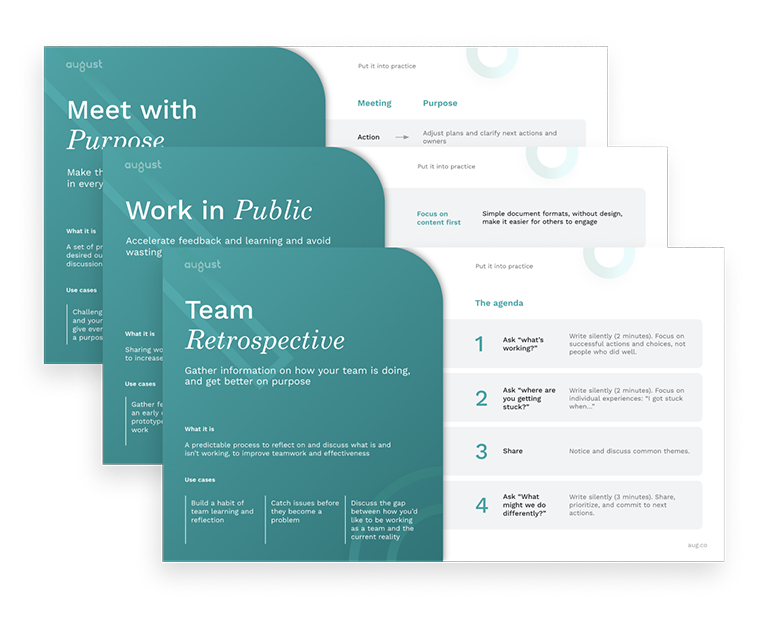Published August 17, 2018 | Updated August 17, 2024 | 7 minute read
Innovative teams need different metrics, here’s how to do it.
Innovative teams inside of organizations are often tasked with tracking their KPIs (key performance indicators) against their company’s quarterly or annual goals. The problem is, KPIs evaluate teams and business units based on how successful they are (or not), are too slow to change, and don’t embrace learning and failure.
Teams doing innovation — testing new products and business models — need to be able to fail and learn in order to be able to adapt and iterate while navigating continuously uncertain conditions. In other words, metrics developed to measure learning, are also just as important to innovative teams.
In this article I will introduce you to OKRs (objectives and key results) and highlight the difference between KPIs and how to use both to measure learning and success within your teams and across your organization.
Back to the Basics — KPIs vs. OKRs
In today’s fast-paced technology driven world, measuring performance looks completely different than that of the 19th and 20th centuries. Regardless of the technique (KPIs or OKRs), the purpose is to measure and review performance in order to learn and adapt your business model or services.
KPIs (Key Performance Indicators) are metrics that demonstrate how a business is performing against its goals. The success of teams and business units are often measured against meeting these targets. KPIs also provide a “north star” for the teams to go out and achieve throughout the year. Each set of KPIs will be different for each organization because business and service model are unique, and every company is in a different state of its evolution.
OKRs (Objectives and Key Results) are metrics that demonstrate how a business or team are meeting its objectives. Objectives are descriptions of what a team wants to achieve, they are meant to bold and ambitious in order to challenge the team. Key results are the measurements tracked toward the progress of each objective. Objectives are qualitative, key results are quantitative. Generally, teams set OKRs on a more frequent basis (e.g. once per quarter) in order to be sure that teams remain agile and adapt to change with shorter objective cycles.

Noticing the Difference
Now you might be thinking, “Ok so what is the difference between measuring KPIs and OKRs?” The difference lies the type of measurements you decide to track. If you are looking to scale or improve upon something that has been done before or falls into the “business as usual” category, KPIs are good enough because they are straight forward to ongoing business processes. For new innovative projects, that have an unclear or uncertain outcome, OKRs are a better fit. OKRs will allow you to set goals, measure, learn, and adapt more quickly.
Innovative teams are often sandwiched between reporting KPIs that are set for the entire business unit and yet must also track more real-time practical OKRs to meet their objectives. It’s important to do both.

Defining OKRs for Innovative Teams
OKRs are meant to be defined by the teams doing the work. Unlike, KPIs they are not intended to be “cascaded” down throughout the organization. Here are a few principles to get started defining OKRs locally:
- Be Ambitious: OKRs are meant to be bold and aspirational and should be challenging for the team to achieve, but not impossible. On the other hand, if your team is reaching 100% of its goals, they might be too easy and you might not be learning much. Aim for a 60–70% success rate.
- Track Regularly: Track your teams OKRs on a weekly cadence. This method is not to simply “report out” but rather ask yourselves, what’s working, where are we getting stuck, what can we do differently? For the week ahead.
- Remain Agile: Adjusting OKRs on a more frequent basis is critical to innovative teams as things change quickly. Adapt objectives on a shorter cadence, for instance quarterly, so that you are prepared to steer your metrics according to what you are learning.
- Be Transparent: Keep your metrics in a publicly shared folder (e.g. Google Drive) so that all team members and stakeholders at any level of your business can access them.
- Keep it Simple: Your OKRs should be memorable and easy to understand. Since you will be adjusting your OKRs on a more frequent basis, you don’t need an extensive list. OKRs should focus on your top priorities between 2–5, no more than 10. Avoid making your OKRs a task list, they should create value and learning rather than efficiency in completing tasks.
Here are a few examples:
Objective: Make a lovable product that excites our customers.
- Key Result #1: Conduct 10 in-depth interviews with enthusiasts
- Key Result #2: Host 3 user workshops locally
- Key Result #3: Increase early adopter engagement by 35%
- Key Result #4: Launch referall incentive program by Nov
Objective: Launch an MVP that users promote to others
- Key Result #1: Generate 10K new registrations
- Key Result #2: Receive product reviews in 15 publications
- Key Result #3: Achieve registration to trial ratio over 25%
- Key Result #4: Achieve trial to paid ratio over 50%
Any team trying something new for the first time can get started on creating OKRs, they don’t have to be reserved for those doing projects that are considered “innovative” or experimental. Give it a shot!
Trying OKRs for the first time with your team? Getting set up with learning metrics for your project? I’d love to hear from you. Connect with me atwww.krysburnette.com









